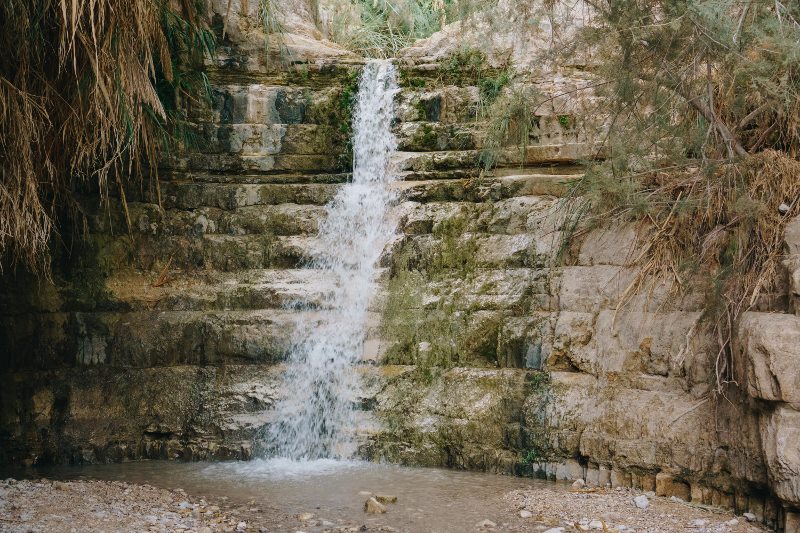A waterfall in En Gedi. (Photo by Haley Black, Pexels)
By Dr. Bill Jones
Shocking Contrast
Imagine a sojourner walking through the bleak, dry, barren Judean wilderness for hours on end. Then suddenly, over the edge of a precipice, he sees below him a river − fed by a waterfall that seems to pour forth from the limestone walls – an oasis of water, trees, shrubs, animals, and fruit.
The contrast of abundant water and life with the barrenness of the wilderness is almost a shock. Such is the experience of many who come upon En Gedi. It is a place of breathtaking beauty and tranquility.
Located halfway down the western side of the Dead Sea, this small but verdant area is mentioned often in the Scriptures. Its name means “Spring of the Goat,” no doubt referring to the herders who brought their goats to its supply of water and foods, as well as the many wild goats, called ibex, that inhabited the area. The springs have never run dry, and the ibex can still be seen drinking from the refreshing waters.
There are 2 beautiful waterfalls which feed parallel canyons, known as Nahal David and Nahal Aargot. On the cliff above Nahal David are the remains of a Canaanite temple dating back to 3,500 B.C. It was probably used by nomadic people who brought their animals to the springs of water.
Biblical References
En Gedi is first mentioned in the Bible in Genesis 14:7 (called Hazezon-tamar, or “Row of Psalms”). We read in Chronicles 20:2 that they are the same place. The small contingency of Ammonites who lived there was destroyed by the invading armies of the plain. Because of the extreme heat of this region of the wilderness, there were never more than small settlements at En Gedi.
En Gedi was a favorite place of refuge for David. It was here that he hid from Saul in one of the many caves. David cut off the hem of Saul’s garment but then apologized to the king (1 Samuel 24:1-15).
It is possible David brought his sheep to En Gedi when he shepherded them as a boy. It was common practice for shepherds to bring their flocks there when the grassy slopes around Bethlehem became bare. If so, David would have been very familiar with the caves and terrain of the area.
Later, when Jehoshaphat was king of Judah, the Moabites and Ammonites encamped there in preparation for an invasion. Jehoshaphat and the people humbled themselves before God and went out to meet the enemy. As the army marched from En Gedi to the wilderness of Tekoa, they fell to fighting among themselves, and all that the Israelites had to do was gather the spoil (2 Chronicles 20:1-25).
Some believe En Gedi was also the place God sent Elijah to be fed of the ravens and have a source of water (1 Kings 17:2-6). The actual spot cannot be pinpointed, but it would be in keeping with En Gedi as a place of refuge.
Plant, Animal Life
Other scriptures make reference to the plants and animals of the oasis. In Song of Solomon 1:14, the “campfire” bush is actually the henna plant. It grows to about 10 feet in height and its highly scented flowers were used to perfume bath water. The leaves were dried and crushed to make a bright yellow, orange, or red dye. It was used for painting fingernails, toenails, and even the soles of the feet and the palms of the hands.
Men, too, colored their beards and groomed their horses’ tails with it. En Gedi was also known for the opobalsam which grew there and was used for bath perfume and medicine. During the Roman-Byzantine period it was famous for its fine dates and rare spices.
A Refuge
Psalm 57:1 is believed to have been written when David was taking refuge in one of the caves at En Gedi. In verse 1 he refers to finding safety “in the shadow of your wings.”
He may have been thinking of the rock doves that made a shelter from the crags and crevices of the canyons. These birds could not defend themselves. They could only hide from their enemies, as David was doing.
During the 3-year siege of Masada, the Romans used Jewish slaves to carry water from En Gedi to the legions attacking the mountain fortress. It must have been torturous work carrying heavy bags and jars of water across 8 miles of hot Judean wilderness.
Today, there is a thriving village also known as En Gedi, which began as a kibbutz in 1953. The area surrounding the springs has been declared a nature preserve.
So, after a fashion, it is still a place of refuge.
Dr. Bill Jones was a longtime teacher / writer with Zion’s Hope.
